
Mitcham is an area within the London Borough of Merton in Southwest London, England. It is centred 7.2 miles (11.6 km) southwest of Charing Cross. Originally a village in the county of Surrey, today it is mainly a residential suburb, and includes Mitcham Common. It has been a settlement throughout recorded history.

Colliers Wood is an area in south west London, England, in the London Borough of Merton. It is a mostly residential area, but has a busy high street around Colliers Wood tube station on London Underground's Northern line. The high street is part of the A24, a major road route roughly following the Northern Line, running from London through Tooting and other areas. The Colliers Wood ward had a population of 10,712 in 2011.

The River Wandle is a right-bank tributary of the River Thames in south London, England. With a total length of about 9 miles (14 km), the river passes through the London boroughs of Croydon, Sutton, Merton and Wandsworth, where it reaches the Thames. A short headwater – the Caterham Bourne – is partially in Surrey, the historic county of the river's catchment. Tributaries of the Wandle include Carshalton Ponds and Norbury Brook.

Merton Priory was an English Augustinian priory founded in 1114 by Gilbert Norman, Sheriff of Surrey under King Henry I (1100–1135). It was situated within the manor of Merton in the county of Surrey, in what is today the Colliers Wood area in the London Borough of Merton.

Morris, Marshall, Faulkner & Co. (1861–1875) was a furnishings and decorative arts manufacturer and retailer founded by the artist and designer William Morris with friends from the Pre-Raphaelites. With its successor Morris & Co. (1875–1940) the firm's medieval-inspired aesthetic and respect for hand-craftsmanship and traditional textile arts had a profound influence on the decoration of churches and houses into the early 20th century.

Liberty, commonly known as Liberty's, is a luxury department store in London, England. It is located on Great Marlborough Street in the West End of London. The building spans from Carnaby Street on the East to Kingly Street on the West, where it forms a three storey archway over the Northern entrance to the Kingly Street mall that houses the Liberty Clock in its centre. Liberty is known around the world for its close connection to art and culture, it is most famous for its bold and floral print fabrics. The vast mock-Tudor store also sells men's, women's and children's fashion, beauty and homewares from a mix of high-end and emerging brands and labels.

Merton is an ancient parish historically in Surrey, but which has since 1965 been part of Greater London. It is bounded by Wimbledon to the north, Mitcham to the east, Morden, Cheam and Cuddington to the south and (New) Malden to the west. The 1871 Ordnance Survey map records its area as 1,764.7 acres (7.1 km2).

The Hat Works is a museum in Stockport, Greater Manchester, England, which opened in 2000. Before that, smaller displays of hatting equipment were exhibited in Stockport Museum and in the former Battersby hat factory.
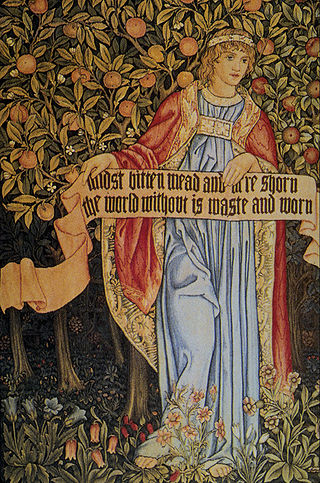
John Henry Dearle was a British textile and stained-glass designer trained by the artist and craftsman William Morris who was much influenced by the Pre-Raphaelite Brotherhood. Dearle designed many of the later wallpapers and textiles released by Morris & Co., and contributed background and foliage patterns to tapestry designs featuring figures by Edward Burne-Jones and others. Beginning in his teens as a shop assistant and then design apprentice, Dearle rose to become Morris & Co.'s chief designer by 1890, creating designs for tapestries, embroidery, wallpapers, woven and printed textiles, stained glass, and carpets. Following Morris's death in 1896, Dearle was appointed Art Director of the firm, and became its principal stained glass designer on the death of Burne-Jones in 1898.
Merton Abbey is an area in southwest London, England. It lies between South Wimbledon and Colliers Wood in the London Borough of Merton. Merton Abbey takes its name from Merton Priory, which once stood on the northern edge of the district. The area is bounded by Merton High Street to the north, the River Wandle to the west, Christchurch Road to the east and Deen City Farm to the south.

Seacourt is a deserted medieval village near the City of Oxford. The site is now mostly beneath the Oxford Western By-pass, about 0.3 miles (0.48 km) south of the Seacourt / Hinksey Stream crossing.

The River Len is a river in Kent, England. It rises at a spring in Bluebell Woods to the southeast of the village centre of Lenham 0.6 miles (0.97 km) from the source of the River Great Stour; both rise on the Greensand Ridge. Its length is c10 miles (16 km). It enters the River Medway at Maidstone.
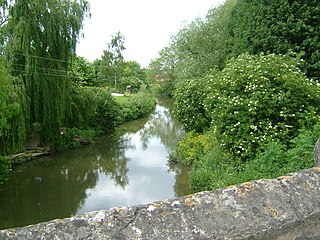
The River Beult is a tributary of the River Medway in South East England.

The Adoration of the Magi is a Morris & Co. tapestry depicting the story in Christianity of the Three Kings who were guided to the birthplace of Jesus by the star of Bethlehem. It is sometimes called The Star of Bethlehem or simply The Adoration.
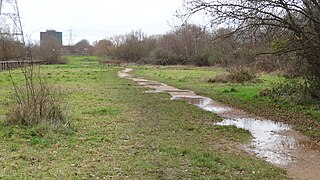
Wandle Meadow Nature Park is a 4.15 hectare local nature reserve and Site of Borough Importance for Nature Conservation, Grade 1, in Wimbledon in the London Borough of Merton. It is owned and managed by Merton Council.

William Morris (1834-1898), a founder of the British Arts and Crafts movement, sought to restore the prestige and methods of hand-made crafts, including textiles, in opposition to the 19th century tendency toward factory-produced textiles. With this goal in mind, he created his own workshop and designed dozens of patterns for hand-produced woven and printed cloth, upholstery, and other textiles.
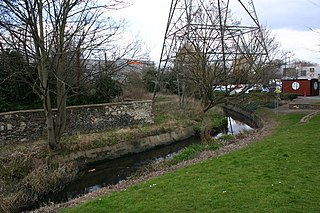
Pickle Ditch, also known as the Pickle, is a minor, 0.9-kilometre (0.56 mi) long stream—brook—in the locality of Colliers Wood in the London Borough of Merton, Greater London, England. Rising from the River Wandle, a tributary of the River Thames, and flowing back into it, Pickle Ditch is the last remaining course of the River Wandle's original course through Merton, before the other sections were straightened.
Bennett's Ditch—sometimes spelled Bennetts Ditch—is a minor river (brook) located in the locality of Colliers Wood in the London Borough of Merton, Greater London, England. It is a tributary of Pickle Ditch, itself a tributary of the River Wandle. Bennett's Ditch ostensibly receives its name from Calico Print Works, which was located in the area and owned by a Mr. Bennett. Bennett's Mill, a textile manufacturing factory, used to be located by the stream.
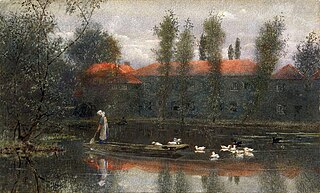
The Merton Abbey Works was a textile printing factory in Merton, then part of Surrey but now in Greater London, England. Textile industries were active there from approximately 1690 until 1940. From 1880 to 1940, the Works were the factory of the Arts and Crafts movement design firm Morris & Co. The Works were demolished after the closure of Morris & Co in 1940.





















